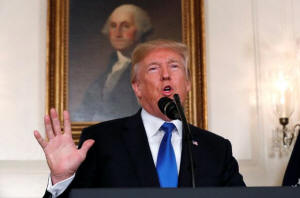|
Pentagon identifying new areas to
pressure Iran, reviewing plans
 Send a link to a friend
Send a link to a friend
 [October 14, 2017]
By Phil Stewart [October 14, 2017]
By Phil Stewart
WASHINGTON (Reuters) - The U.S. military
said on Friday it was identifying new areas where it could work with
allies to put pressure on Iran in support of President Donald Trump's
new strategy, which promises a far more confrontational approach to
Tehran.
Trump struck a blow against the 2015 Iran nuclear agreement on Friday in
defiance of other world powers, choosing not to certify that Tehran is
complying with the deal and warning he might ultimately terminate it.
He also promised to address Iran more broadly, including its support for
extremist groups in the Middle East.
Major Adrian Rankine-Galloway, a Defense Department spokesman, told
Reuters the Pentagon was assessing the positioning of its forces as well
as planning but offered few details.
"We are identifying new areas where we will work with allies to put
pressure on the Iranian regime, neutralize its destabilizing influences,
and constrain its aggressive power projection, particularly its support
for terrorist groups and militants," he said.

U.S. Defense Secretary Jim Mattis said his first goal would to talk with
U.S. allies in Europe, the Middle East and elsewhere to gain a shared
understanding of Iran's actions.
"Certainly we intend to dissuade them from shipping arms into places
like Yemen and explosives into Bahrain and the other things they do with
their surrogates, like Lebanese Hezbollah," Mattis said.
The U.S. military has long been a strident critic of Iran, accusing it
directly and indirectly of trying to undermine the United States and its
allies, including in Iraq, Syria and Yemen.
The tensions escalated in recent months in Syria, where American pilots
shot down two Iranian-made drones this summer.
Still, a more aggressive approach to Iran could trigger a backlash from
Iran's elite Islamic Revolutionary Guard Corps (IRGC) and forces that it
backs. That includes in Iraq, where U.S. troops are fighting Islamic
State and trying to keep their distance from Shi'ite militia aligned
with Iran.
"U.S. forces in Iraq are quite exposed, and coalition forces are quite
exposed to the risk of attack if Iranian elements so choose," said
Jennifer Cafarella, lead intelligence planner at the Institute for the
Study of War, a think-tank in Washington.
The U.S. military is analyzing an explosively formed penetrator, or EFP,
that killed an American soldier in Iraq this month. The reappearance of
the device, which Iran-backed Shi'ite militia routinely used to target
American troops in Iraq before their withdrawal in 2011, has startled
U.S. officials.

[to top of second column] |

President Donald Trump speaks about Iran and the Iran nuclear deal
in front of a portrait of President George Washington in the
Diplomatic Room of the White House in Washington, U.S., October 13,
2017. REUTERS/Kevin Lamarque

LINK TO IRAN?
CIA Director Mike Pompeo noted the device was detonated in an area
controlled by a militia backed by Tehran.
"We do not have evidence of a direct link to Iran, but we are
closely examining this tragic incident," Pompeo said on Wednesday.
Cafarella said the killing of the U.S. soldier may have been a
warning from Iran.
"I think it is possible that the Iranians have been attempting to
signal their commitment to retaliate against the U.S. strategy," she
said.
Mattis said the United States was watching for any new provocations
from Iran.
Asked whether he thought Tehran might retaliate, he said: "It would
be ill advised for them to attack us."
Reuters has previously reported that options to increase pressure on
Iran include more aggressive U.S. interceptions of Iranian arms
shipments, such as those to Houthi rebels in Yemen, It could also
direct U.S. naval forces to react more forcefully when harassed by
armed IRGC speed boats.
The Pentagon on Friday detailed a series of major concern about
Iran, including its ballistic missile development and cyber attacks
against the United States and U.S. allies.
The Pentagon promised to review U.S. security cooperation activities
with allies in the region, something that could lead to alterations
in U.S. arms sales and military exercises.

It also signaled a willingness to re-examine the positioning of the
roughly 70,000 American troops the Pentagon says are stationed in
the Middle East.
Still, Mattis said: "Right now we are not changing our posture."
(Reporting by Phil Stewart; Additional reporting by Idrees Ali
traveling with Mattis and Jonathan Landay in Washington; Editing by
Jonathan Oatis and James Dalgleish)
[© 2017 Thomson Reuters. All rights
reserved.]
Copyright 2017 Reuters. All rights reserved. This material may not be published,
broadcast, rewritten or redistributed. |